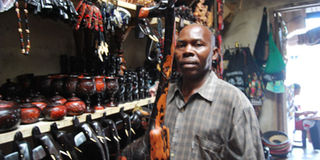Neem tree now replaces disappearing mpingo

Woodcarver showcases his artwork at his Mwenge pavillion. Carvers are now turning to the Neem tree as the African Blackwood also known as Mpingo is disappearing. PHOTO | The Citizen Correspondent
What you need to know:
- The idea of using the neem tree was developed in a cluster programme that was financed by the government through Costech as part of promoting innovation as the mpingo disappears
Dar es Salaam. Dwindling supplies of the African Blackwood species, one of the world’s most economically valuable timber is posing a big threat to the wood carving industry with carvers now opting to use the Neem tree to cope with the scarcity.
The African Blackwood, also known as Mpingo in Swahili is known for its characteristic of improving soil fertility and maintaining soil stability.
Prices for the tree have currently hit the roof whereas it is hard to find in Dar es Salaam. For that reason, many wood carvers at Mwenge in Dar es Salaam have opted to use the Neem tree instead.
The idea of using the Neem tree was developed in a cluster programme that was financed by the government through the commission for science and technology (Costech) as part of its mandate to promote innovation.
The programme has enabled wood carvers and stakeholders from Mwenge to team up with experts from the University of Dar es Salaam to produce products that can compete in the international market.
The cluster that was founded in 2012 comprises exporters, wholesalers and carvers from 12 registered organisations.
Mr Deaodatus Kafwa, a wholesaler and exporter of carvings was the facilitator of the cluster. He says that using the Neem tree has reduced material costs and has increased sales.
According to Kafwa, the artwork from the Neem tree has attracted more customers. He says that his team is currently sampling coconut trees as another alternative so as to foster an eco-friendly operating environment.
“We appreciate the assistance we got from experts from the University of Dar es Salaam - Department of Forestry for giving us knowledge on the characteristics of various trees and marketing skills,” he says.
Mr Kafwa says that they used funds from the government to strengthen the cluster administration and pay salaries to carvers who took their time off their daily duties to focus on new inventions.
‘‘Most of the craftsmen depend solely on their work to earn a living. So they fear spending their time creating new things that might not sell,” he says.
The group is liaising with the engineering cluster to develop curving machines so as to increase the working pace.
‘‘Our work is hand-made, we have experienced cases whereby foreigners duplicate our work using machines which are sold at cheaper prices,” he noted.
Finding markets, however, remains a challenge to the group.
‘‘The number of craftsmen is growing while that of customers has remained more or less the same,” he added.



